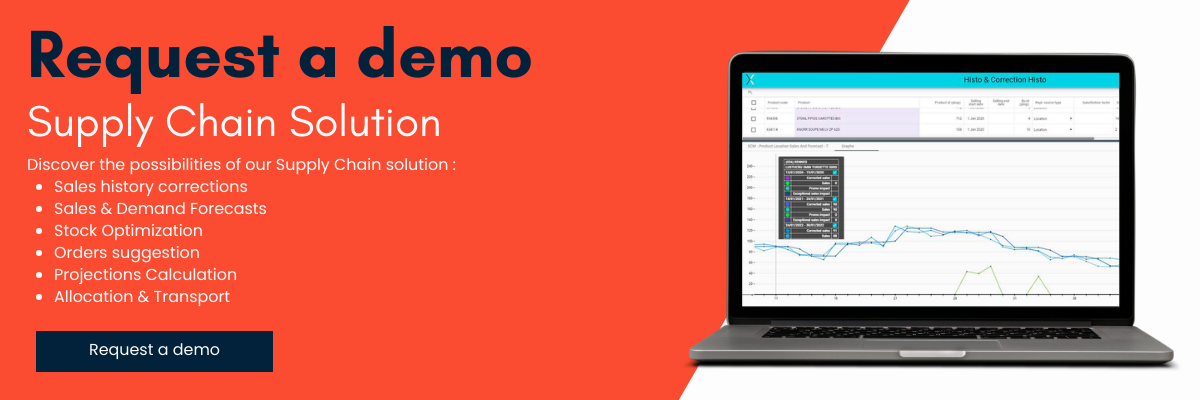Planning is a key factor in supply chain efficiency: to guarantee optimum product availability in line with set objectives, the various players involved (distributors, manufacturers, subcontractors) need to be able to plan their activities sufficiently in advance.
Planning encompasses the management of production capacity, raw materials purchasing, inventory management, etc. It aims to provide answers as to how the players involved in the supply chain are going to meet forecast demand, while optimizing resources and controlling costs.
At a more operational level, scheduling concerns the concrete allocation of resources, tasks and activities to achieve the plan established during the planning phase.
In a CPFR or VMI logic, supply chain improvement relies on increased collaboration between distributors and suppliers.. Sharing forecasts and projections should help each link in the chain to better plan its activity and schedule its operations.
In this article, find out why and how, thanks to the shared forecast, supply chain players could synchronize their action plans to optimize the supply chain.
Constantly evolving consumer demand
Ensuring product availability
In the supply chain, the main objective is clear for distributors, manufacturers and subcontractors. All logistics players need to organize themselves in order to ensure product availability in line with objectives.
To guarantee this level of availability, retailers require a commitment from suppliers that expected volumes can be met.
At the same time, suppliers are hungry for information about the projected number of orders they will have to process, and the workload they need to anticipate.
To improve product availability, the distributor needs to communicate order forecasts or projections in advance, so that the supplier can get organized, plan his workload and anticipate raw material purchases.

Fierce competition in the retail sector
Another advantage of collaborative planning is that it creates a calmer relationship between distributor and supplier.
The supplier can rely on the forecast shared by the retailer to anticipate and plan ahead. He has a long-term view of his business, which may enable him to forecast resources, anticipate purchases of raw materials, optimize investments and guarantee the long-term viability of his business.
It can also anticipate and smooth out peaks in promotional activity, since the information is transmitted to it in advance.
Conversely, when the forecast is not shared, the supplier is subject to variations and fluctuations in orders. He must always have stock in advance, …
For the distributor, the benefits are immediate in terms of availability, supplier reliability and therefore stock levels of security. Substitution plans are easier to implement because they can be anticipated in the event of failure of one of the two players (material shortage, production capacity constraints, etc.).
Using technology to optimize assortments
For suppliers, the information shared by major distributors enables better management of storage capacity.
They have several months’ visibility on orders, deliveries and stock projections. Ils peuvent donc adapter leur stock en conséquence et optimiser le stock tampon pour rationaliser les coûts de stockage.
For certain products, such as water, whose production rate is not in line with the season, the supplier knows in advance how quickly his products will sell out. He can therefore define the storage capacities he needs, choose the warehouses where he will store them, and know in advance when he will need to draw on his reserve stock.
With this knowledge, he can save logistical space or anticipate his needs more easily.

Benefits of assortment optimization
When stakeholders share information in advance, planning becomes more efficient at all levels. It allows you to reduce operating costs on several levelsspan
- Storage costs
- Transport costs
- Labor costs : the supplier anticipates the production rate in advance. In this way, he can adjust human resources, for example by planning the use of temporary staff during peak periods.
- Production costs : production is adjusted according to forecasts and projections. Schedules its production trains on its various lines, according to their technical performance and current and future order portfolios. In this way, the supplier avoids unnecessary over-production and overstocking.
The benefits of using a pricing solution to optimize assortments
Collaborative planning also encompasses resource management:
- Purchase of raw materials
- Human resources
- Production capacity: here too, collaborative planning is beneficial. For example, it helps manufacturers anticipate their purchasing needs . If necessary, it can avoid a shortage or work out a substitution plan with the retailer.
- Transport and storage capacity: the supply chain involves numerous intermediaries, notably carriers and subcontractors. Collaborative planning makes it possible to effectively communicate order forecasts and projections to these players. Carriers, for example, can better plan their resources. They can anticipate the eventual recruitment of a driver to meet a surge in activity, bearing in mind that this can take several months for certain professions (shortage, training time, FIMO).
Understanding the advantages of pricing
Lack of collaboration between retailers and suppliers generates avoidable waste.
To avoid shortages, manufacturers over-stock. Excess stock increases the risk of breakage and loss, with an obvious ecological impact.
Optimal communication of forecasts and projections is therefore also the sinews of warfor a more resource-efficient and environmentally-friendly supply chain.
Conclusion
As a general rule, forecasts and projections are shared 6 months in advance to give partners sufficient visibility.
Nevertheless, the visibility window must be adapted to the type of product, depending in particular on the lead time, the specific features of the production or the number of intermediaries.
To illustrate the importance of planning, let’s take 3 examples.
Meat and poultry
In trades such as meat and poultry, forecasting is essential, as the product’s optimal consumption window is very short.
By collaborating effectively on planning, we can easily imagine the supply chain, which receives order forecasts from the retailer, sharing the information with all the players involved. The latter will then be able to integrate the capacity requirement at the insemination stage.
In the same way, a poultry supplier needs to ensure that the chicken reaches maturity at the right time for projected orders. If it’s ready too early, we’ll have to continue feeding it, and so costs will rise. As a result, he has every interest in building on the shared forecast so that the product reaches maturity at the right time.

Water
Collaborative planning is also essential in the bottled water market.
In fact, the quantity of water produced by thermal springs is stable. In winter, the producer produces and stores water, and demand is lower than production. On the other hand, for part of the year, demand outstrips production.
In this context, having several months’ visibility on product sales for major distributors and private labels enables us to better define storage capacities and optimize space and logistics costs.

How can collaborative management between supply chain players be implemented?
In operational terms, this collaborative management approach is perfectly feasible. The concepts of CPFR (Collaborative Planning, Forecasting and Replenishment)or VMI (Vendor Managed Inventory) have been around for several years, and are well known to supply chain players.
Forecasting solutions, such as Optimix, enable us to establish reliable order forecasts and projections by product type, several months in advance, taking into account influencing factors and promotional activity. These tools make it easier to share the forecast with all stakeholders in the chain, in particular from the retailer to its suppliers.
On the face of it, the conditions are ripe for the players to synchronize and deliver substantial efficiency gains in the supply chain. Distributors can communicate this information to their suppliers, so that they can organize themselves to ensure optimum product availability, while controlling resources and costs.
Nevertheless, resistance persists. Some retailers remain reluctant to share information with their suppliers in order to retain bargaining power. In so doing, they deprive themselves of a lever for supply chain efficiency. The question is: is it better to optimize availability, or is it better to compartmentalize information to negotiate from a position of strength?
Eventually, with the arrival of new competitors (pure web players, sales aggregators, etc.), collaboration should become a real competitive advantage.
Conclusion
Collaborative planning and forecast sharing offer considerable advantages for supply chain efficiency.
From an operational point of view, forecast sharing is relatively simple to implement, and its virtuous effects on the supply chain are well known: better anticipation of demand, optimization of resources, cost control and improved product availability.
However, the implementation of collaborative planning still comes up against the logic of silos between players who wish to preserve their turf and their bargaining power. However, the evolution of retailing and the emergence of new competitors call for decompartmentalization and collaboration.
In addition to efficiency gains, the collaborative approach also meets the challenges of the green supply chain and sustainability.
Ultimately, this is not just a short-term solution, but a key step for the future of the supply chain. It paves the way for a more agile, efficient and resilient supply chain, ready to meet the challenges of the future.



